Abstract
Networking services may be broken down in a disaster situation while people in the disaster area(s) strongly demand networking services for both communication and information sharing among users. This requires the fast restoration of networking services to fulfil the demand–supply gap. Although there are a number of studies on restoring communication and networking in disasters, few studies have explicitly examined the service availability during the temporary and partial recovery process of network restoration. From the perspective of users in the disaster area, it is important to be able to communicate or share information with people whenever they want/need to do so. Therefore, partial and local recovery of the networking services also plays an important role for improving service availability in the disaster situations. To assess the restoration effectiveness of networking services with a measure of user satisfaction level, we propose to use instant networking service availability (I-NSA), a novel metric, and we examine the effectiveness of networking service restoration solutions using the metric. I-NSA allows us to clearly express the instant availability of networking services that drastically changes with the elapsed time from the disaster occurrence in disaster areas. This paper examines the effective improvement of I-NSA when Local-and-Instant Clouds (LI-Clouds) are applied to the disaster situation. LI-Cloud has been designed and practically developed to provide deployable networking services to users. We verify that LI-Cloud enables significant improvement on the I-NSA performance in the fast restoration of networking services.
1. Introduction
Communication network equipment, including cables, switches, routers, and data servers, is prone to damage in large-scale disasters such as earthquakes, tsunamis, floods, and typhoons [1,2]. The breakdown of communication services such as telephone and the Internet causes serious problems in efficiently supporting the disaster countermeasure activities and the people affected by the disaster.
A number of studies have investigated the resilience of networks by means of improving networking and service functionality for emergency communications [3]. Local networks such as ad hoc networks, smartphone relay network, and mesh networks enable local data communication among users. Movable base stations (BSs) and delay-tolerant networks (DTN) provide link recovery and temporary services via network access in a flexible manner [4]. Moreover, a satellite connection car allows local users to have remote network access [5,6].
The basic measurement of networking service performance, even in a disaster situation, includes quality of service, energy efficiency, etc. [7]. Furthermore, system reliability is a metric that has been used in evaluation of communication stability between terminal pairs. For example, a good communication link with low bit error rate (BER) and high data delivery ratio is preferred for improving the reliability of multihop wireless communication [8]. Availability is an important metric to assess the network system performance in emergencies. Mean time between failures (MTBF) and mean time to repair (MTTR) are major methods used to assess the availability [9]. For example, the availability can be evaluated as . People in the disaster region strongly demand the prompt restoration of networking services, such as information sharing and communication support, due to the time limitation for the rescue. In the real disaster situation, however, some time is needed for network restoration because of its complex process. The disaster region usually consists of multiple service areas that need multiple local networks. The distance between areas may be long. Considering real recovery cases, time is needed for the deployment of the infrastructure of local networks and construction of links to the global network. Consequently, the restoration procedure of the user networking service is a time-dependent and multiphase procedure.
The studies on network restoration have paid little attention to the restoration process from the time of deploying local communication service to the time of recovery of the whole communication service, including the global network connection. The restoration should be measured by the user-centric availability of networking service and the speed of the restoration procedure of user services. Conventional measurement of availability focuses on one system object—either the whole system or its components. On the other hand, the user-centric availability of networking service is a measure that involves the integrated availability of a set of network infrastructure nodes and links in the local areas.
The network restoration system being examined in this study is Local-and-Instant Clouds (LI-Clouds), which enable prompt and conventional networking service restoration in the disaster environment even when there is no Internet connectivity [10]. Distributed cloud services facilitate local users to communicate with each other, sharing information such as rescue route, map, and disaster status. The motivation of providing prompt and local networking service with LI-Clouds is based on the observation of communication features and population distribution in the emergency situation. First, it is observed that the majority of communication destinations of a user are in the nearby area [11]. Second, residents in the disaster situation tend to gather at the designated safe places such as shelters or evacuation centers [12,13]. Hence, even in the absence of conventional global communication services, the prompt and local cloud services are expected to be effective in quickly increasing the availability of networking services [14].
The goal of this paper is to study the networking service availability within the process of the whole network recovery. Since partial and local recovery of the networking services also plays an important role in a disaster situation, it is necessary to examine the temporal and spatial aspects of the process of networking service recovery [14]. At first, we propose to use a novel metric, instant networking service availability (I-NSA), in order to measure the time-varying efficiency of service restoration from the user side. I-NSA quantifies the instant availability of the networking service as the possibility that a user can communicate with any other users. We then measure and prove the efficiency of the networking restoration process based on LI-Cloud using I-NSA. Since I-NSA involves multiple factors of network connection status, as well as distribution of users, our study based on I-NSA enables an explicit description of the overall restoration status, even including the local and partial recovery of user services in a disaster situation.
The evaluation results show that the methods based on the LI-Cloud system significantly improve the overall service availability for users. Analyses of evaluation results on I-NSA prove the advantage of the LI-Cloud method. In addition to that, I-NSA is shown to be useful in assessing the restoration strategy of a network system.
2. Related Work
We classify the studies related to our work into three categories: (1) recovery of communication failures, (2) information sharing system that collects and provides supporting information to users in disaster, and (3) statistical study of communication features, system availability, and reliability.
2.1. Recovery of Communication Failures
There are various types of communication failures. We can classify the failure recovery methods according to failure causes: bit error failure recovery, packet delivery failure recovery, route failure recovery, and infrastructure failure recovery. IP/TCP networking technologies involve the protocols and methods for the bit error failure recovery and packet delivery failure recovery [15]. Route recovery has also been examined in a number of research studies in IP networks and other network such as mobile ad hoc networks and software-defined networks (SDN) [15,16]. For instance, [17] addressed the problem of service function chaining (SFC) using the concept of network function virtualization (NFV) in software-defined networks with reliability. The authors proposed a fault-aware routing architecture for the SFC problem with energy consideration. Mathematical study has been carried out to examine failure recovery and fault minimization. The proposed scheme optimizes the probability of failure in networking devices and in the event of failure of (a) Fog node(s).
In the disaster situation, the network infrastructure may be broken down and may fail to work. In this paper, we address the problem of network restoration (infrastructure failure recovery) for disaster resilience. Communication support systems and information support systems are essential for disaster resilience. The communication means in a disaster situation are based on the extended utilization of conventional communication technologies such as WLAN, LTE, Bluetooth, satellite communications, etc. The combination of short-range and long-range communication facilitates disaster responses such as telemedicine [3,18].
Various communication systems have been developed for disaster situations.
Two studies by Sakano et al. ([1,19]) introduce the movable and deployable resource unit (MDRU) and van-type MDRU. The idea of the MDRU is to enable rapid transportation of a communication resource unit to the disaster areas. The MDRU constructs an alternative network to the damaged network, providing networking services such as telephone services and Internet connections. A van-type MDRU was introduced in [1]. A van-type MDRU can be connected with a satellite or LAN in addition to the wireless access interfaces.
Ngo et al. [7] introduced a spectrum- and energy-efficient route management scheme for MDRU-based networks. The network considered in this study consists of a number of deployed gateways that connect to the Internet through the MDRU. The study proposed a scheme of finding a routing path from multiple nodes to multiple forwarders with consideration of both energy efficiency and spectrum efficiency in an MDRU-based network.
There are also other types of networks for disaster areas. Mobile ad hoc networks are used for situation awareness in disaster areas. Relay by smartphone allows users to directly communicate, and it supports multihop relay. Smartphone relay networks are introduced in [4].
2.2. Information Sharing Systems for Disaster Resilience
In addition to communication systems, the information sharing system is also important for supporting people in emergencies, with functionalities such as warning, estimation of damage, safety confirmation, rescue guidance, etc.
Many efforts have been devoted to the development of information sharing systems for disaster situations and emergencies. Usuda et al. [20] introduced an information sharing platform, named the SIP4D system, that facilitates mutual information exchange among various information systems. The SIP4D system has an objective of realizing mutual information exchange among various systems. It employs an onsite response team to collect information and identifies the needs at the site of the disaster. The collected information is transmitted to the SIP4D information system, which manages the information and can release the information to public.
Furthermore, Uchida et al. [21] introduced a real-time information sharing system based on Twitter. The developed system provides location information and nearby information to users. Aydin et al. [22] proposed an information supporting system that allows users to actively play a role in disaster management.
2.3. Study of Statistical Communication Features, System Availability, and Reliability
Lambiotte et al. [11] investigated the statistical properties of communication networks that support phone calls and text messages. Based on the introduction of geographical home location, the study shows that the probability that two customers communicate with each other over the network decreases with the distance between the customers, following a gravity model [23].
It is observed that residents in the disaster situation tend to gather at the designated places such as shelters or evacuation centers [12]. Zhao et al. [13] examined the relationship between evacuation population size, emergency shelter capacity, and evacuation time. The proposed model was considered to facilitate decision-making on the position of emergency shelters and the allocation of evacuees to the shelters.
The availability of a communication system can be generally measured by mean time between failures (MTBF) and mean time to repair (MTTR). The availability can be computed as . Meza et al. [9] studied the reliability of the data center. For a large system such as a data center, an entity or component instead of the whole system may have failures. The MTBF- and MTTR-based availability measurement can apply to measure the availability of a component or entirety of a system.
Dominiak et al. [8] introduced the reliability of communication pairs in IEEE 802.16-based mesh networks. It is shown that selecting a reliable path by avoiding poor links is important for the network to achieve higher data rate and low bit error rate (BER).
Hazra et al. [24] introduced a resource allocation scheme in order to ensure the good communication quality in terms of latency and packet delivery ratio. The network resources include data mules and communication towers. The basic idea involves that each shelter is served by at least one network resource and involves trying to minimize the end-to-end network latency between the volunteer and control station. The proposed scheme increases the packet delivery ratio and reduces the communication latency compared with the resource-unplanned system.
Nakamura [25] showed the results that the fixed telephone system did not have a good performance in terms of service connectivity under a large earthquake situation. However, social networking service (SNS) communication via mobile phone had high connectivity performance, since the control for packet communication was independent with that of voice communication.
In summary, a number of studies have addressed the communication systems and information sharing systems that support the capability of disaster resilience. However, few of the previous studies explicitly addressed the effectiveness of prompt and partial recovery of networking services and the speed of network restoration in the disaster situation according the communication features and population distribution. Moreover, it is difficult to utilize the conventional metrics on system availability and reliability to assess the effectiveness of temporary and partial recovery of networking services. Considering communication and population distribution in a disaster situation, local and partial recovery of networking services should also facilitate communication among users. This paper explicitly addresses the effectiveness of user service restoration procedure before the network is fully recovered, and examines the instant availability of networking service in a disaster situation. We evaluate the instant availability of networking service based on a local cloud system that enables the joint provision of communication support and information support for users in the disaster situation.
3. System Architecture
3.1. Conventional Restoration Process
A network or cloud service such as Facebook or Twitter basically relies on the Internet. Theses global services confront with breakdown in emergencies. The restoration process of global services is a procedure that allows servers and routers to work again or to be replaced. Hence, the restoration process may take a few days or even a few months when there is large-scale damage in a disaster.
In the conventional restoration method, both connections to the local infrastructure nodes (such as BSs) and global network are required to exist or to be recovered for communication between users.
3.2. System Overview
An LI-Cloud system that is introduced in this paper provides networking services such as messengers and voice communications. Hence, even when there are no global networking services, the launching of an LI-Cloud allows users in the cloud to communicate with each other.
Multiple LI-Clouds will be deployed at different places in a disaster region. The correlation of launching times may exist among multiple LI-Clouds according to their deployment sequence. When multiple clouds are deployed independently and in parallel, their launching times are independent of each other. When the LI-Clouds are deployed in sequence, the launching times are correlated in a time sequence. The global connection of each LI-Cloud is also carried out during the restoration.
Figure 1 shows an example of a resilient network based on LI-Cloud service in disaster areas. In the example, there are three areas—A, B, and C. In conventional restoration, users can communicate with other users only when both local network and global network connections are recovered. By utilizing LI-Cloud, as shown in Figure 1, a user is able to communicate with other users in the same local area before the connection to the global network is recovered. When a disaster area is recovered, the users in the area are able to communicate with the users in other areas that are connected to the global networks.
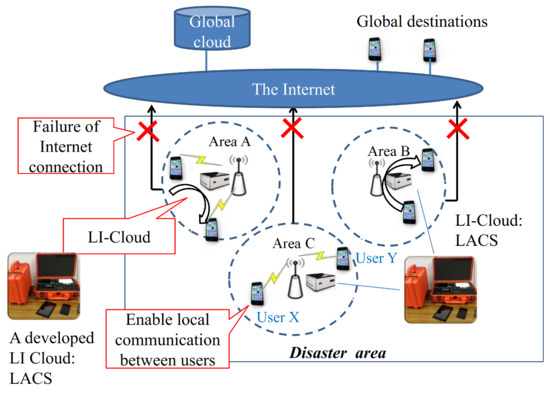
Figure 1.
System overview.
3.3. LACS: Locally Accessible Cloud System
LACS (Locally Accessible Cloud System) is a portable LI-Cloud system that we have developed with an aim of providing conventional Internet services even when the Internet connectivity is not available. LACS attempts to deliver cloud service anytime anywhere and in various network environments, even in the devastated disaster situation [10].
As shown in Figure 2, an LACS server is comprised of a compact server, Wi-Fi access point, battery, and peripheral devices. As shown in the figure, functions offered by an LACS include important notices, a bulletin board, and messaging. These functions support information broadcasting, information sharing, and bidirectional, voice, and video communication among users in the area surrounding the LACS. A user is able to access the service using his/her network device, such as a smartphone, over Wi-Fi functionality. An LACS enables us to handle large size contents in the form of text, voice, moving picture, or still image. LACS collaborates with other systems on the Internet, such as a system for a disaster countermeasure.
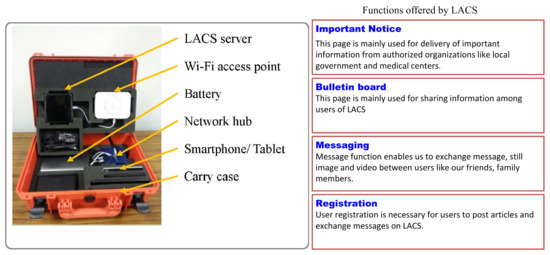
Figure 2.
LACS structure overview.
An LI-Cloud system involves the software and hardware development that support the networking services as a standalone server for the local user scope [26,27]. LACS offers a tool for communication in the disaster-affected area that provides various services such as:
- Operation without power feed
- Delivery information by local government
- Collection and delivery of disaster information
- Offer person-to-person bidirectional communication tool
In addition to providing prompt services in emergencies, the LACS is also available for use as a local information system in a normal situation, such as information sharing in schools and shopping malls. The major energy consumption at the server of a LI-Cloud system involves the energy consumption at the Wi-Fi Access Point regrading communication activities, and the energy consumption at the CPU and data processing. The LI-Cloud adopts a battery power support and a backup battery. The coverage of the LI-Cloud is associated with a Wi-Fi-based communication system. There are several ways to extend the coverage of LI-Cloud such as employing multiple LI-Clouds and enabling interconnection of multiple LI-Clouds [14]. Furthermore, in emergencies, deploying the LI-Clouds to shelters facilitates the effective coverage of users when they are gathered at the shelters.
4. Networking Service Availability: An Integrated Measure of User Service Restoration
4.1. Networking Service Availability for Users
Let X and Y denote communication source and destination, and Ax and Ay denote the local areas where X and Y reside. For example, in Figure 1 the set of areas where X may reside is expressed as . The set of areas in which Y possibly resides is denoted by , where G refers to globally connected areas. Hence, the combinational cases of X and Y location are represented by the Cartesian product set of and , being denoted by . Due to the same communication requirement, we combine the cases of AB and BA, BC and CB, and AC and CA to simplify the number of cases to analyze. Hence, we simply express the cases of X and Y location combination, by . In this expression and what follows, AB refers to the fact that either X is in A and Y in B, or X is in B and Y in A. The same expression rule is applied to cases of AC and BC.
To explicitly measure the speed of network restoration procedure, we adopt the metric of the instant networking service availability (I-NSA) between X and Y at a time t as the probability that X is able to communicate with Y at the time t. We note that the I-NSA of a user X in a disaster region correlates with the integrated availability of local servers and global connectivity of the local areas that X and Y reside.
In a conventional way, the conditions that X can communicate with Y are: (1) the area where X resides is locally recovered with both local and the Internet connections, and (2) the area where Y exists is provided with both local and global network connections.
We can generally write the I-NSA of X at time t, for x in Ax, and y in Ay, as
where refers to the probability that the local server at Ax is launched, refers to the probability that the local server at Ax is launched, refers to the probability that the global connection at Ax is launched, and refers to the probability that the global connection at Ay is launched.
4.2. Networking Service Availability Improvement by Utilizing LI-Clouds
We at first suppose that an LI-Cloud is immediately available for local users when the conventional networks breaks down. In later sections, we will discuss in detail about the network restoration process by taking into account the launching time of LI-Clouds. By utilizing the LI-Clouds that are immediately available for local users in an emergency, the conditions that X can communicate with Y are (1) X and Y reside in the same recovered LI-Cloud area even when there is no global network connection, or (2) the area where X resides is locally recovered with both local and global network connection, and the area where Y exists is provided with both local and Internet connections. Suppose that an LI-Cloud is immediately available for local users in an emergency. By utilizing an LI-Cloud, we have
when .
Consequently, the improvement ratio on I-NSA by utilizing an immediately available LI-Cloud can be expressed as
when X and Y are in the same area—that is, for the two users in the same area, the improvement of I-NSA is in reverse proportion to the product of the probabilities of the global connectivity in the areas where X and Y reside. We consider that the improvement of I-NSA by utilizing the LI-Cloud is mainly due to that LI-Clouds provide the alternative networking service of global networks if the LI-Cloud can be quickly deployed before the global network restoration.
5. Restoration of Networking Service Availability for Users in Multiple Areas
In what follows, we analyze the the temporal and spatial features of restoration process in detail regarding the networking service availability for users. We take the time consumption in launching each LI-Cloud and the global network into account. The list of symbols is shown in Table 1.

Table 1.
Notation.
The basic scenarios studied in the evaluation involve three areas, as shown in Figure 1. There can be various scenarios in a disaster situation. It may also be difficult to adopt a few scenarios to represent all others. Hence, we try to employ the scenarios that reflect the basic functionalities and fundamental operations in network restoration, involving (1) local connections and their restoration and (2) global connections and their restoration.
5.1. Conventional Restoration Process without LI-Cloud
Let denote the probability of successful communication connection between X and Y, which are in A. Since any user needs to connect with another user through the global network, we then have
In the same way, we can express
and
Let denote the probability of successful communication between X and Y in case either X is in A and Y in B, or X is in B and Y in A. We have
To summarize the previous statement and equation, a user in A is able to communicate with B only when local servers are launched in both areas A and B, and both areas A and B are connected with the global network.
In case either X is in A and Y is in C, or X is in C and Y is in A, we have the probability of successful communication between X and Y as
In case X is in A and Y is a global destination, we have the probability of successful communication between X and Y as
In case either X is in B and Y is in C, or X is in C and Y is in C, we have the probability of successful communication between X and Y as
In case X is in B and Y is a global destination, we have the probability of successful communication between X and Y as
In case X is in C and Y is in C or is a global destination, we have the probability of successful communication between X and Y as
Let CaseAA denote that one user in A attempts to communicate with one user in A, and the communication succeeds. Let denote the probability for (CaseAA). We have
In the same way, we can express for Case AB, for CaseAC, for CaseAG.
Let CaseBB denote that one user in B attempts to communicate with one user in B, and the communication succeeds. Let the probability of CaseBB be . We have
In the same way, we can express that for CaseBC, for CaseBG.
Let CaseCC denote that one user in C attempts to communicate with one user in C, and the communication succeeds. Let Probability of (CaseCC) be . We have
In the same way, we can express that .
Consequently, the availability probability of is then expressed as
5.2. Network Restoration Based on LI-Cloud
By employing LI-Cloud, network restoration is enabled by two phases. One is the local restoration process. Another is the global restoration process. The local restoration process refers to the launching of LI-Cloud service for the local users. The procedure allows LI-Clouds to be deployed and configured in an isolated area after a disaster. The deployment of the LI-Cloud server can be carried out with cars, by a human, or just by switching on a predeployed server. The global restoration process refers to the procedure for connection to global services, such as social media tools. The analytical scenario adopted in this section assumes that there is no interconnection among LI-Clouds in different areas.
The differences of the proposed LI-Cloud method from the conventional networking service provision are as follows.
In case X is in A and Y is in A, we can write the probability of communication connection between X and Y as
In case X is in B and Y is in B, we can write the probability of communication connection between X and Y as
In case X is in C and Y is in C, the probability of communication connection between X and Y is
Let the probability of CaseBG be . We have
Let the probability of CaseCC be . We have
Let CaseCG denote that one user in C communicates with one user over the global Internet. Let Probability of (CaseCG) be . We have
The availability probability of is then expressed as
Consequently, the average improvement on the I-NSA by utilizing multiple local clouds can be expressed as
To summarize the previous statement and equation, the average improvement of I-NSA for any two users, in all cases of their location, depends on the user location, and the probabilities of the local and global connectivity at the time.
6. Numerical Examination
Numerical examination is conducted to assess the performance of the proposed scheme in comparison with the conventional scheme. The aim is to identify the effectiveness of I-NSA in measuring networking service restoration that includes partial and/or temporal restoration phases on the way to the complete restoration. We then verify the I-NSA improvement by utilizing the restoration method based on LI-Cloud.
We attempted to allow the evaluation to involve the following three aspects. First, potential users are widely distributed in the disaster region, which comprises multiple local areas. A user in a local area may communicate with other users who are inside the local area, in the different local areas, or outside of the disaster region. Second, probability of communication occurrence among users depends on the distance between the users [23]—that is, a user communicates more with people in the nearby places rather than the people faraway. Third, partial and temporal restoration of a networking service can support the communication among users nearby.
Based on the aspects above, we set up the following evaluation scenarios. The disaster region consists of three local areas denoted by A, B, and C. A user in the disaster region tries to communicate with other users either in the same local area or outside the areas. We assume the probability of a user communication occurrence as shown in Table 2, in which the probabilities were derived based on the gravity model that a user has a higher probability to communicate with other users nearby than with users who are far away [23]. More specifically, we suppose that the probability of communication between two users is in reverse proportion to the distance between them. Let the probability of the emergence of communication between two users in A be 0.2. Suppose that the average distance between two users in A and B is about 2.8 times of the distance between two users in A. Then, we set the probability of communication between two users in A and B as 0.025. Although there can be various parameter configurations in evaluation, we employ the setup in Table 2 to represent the basic features that are involved in the evaluation aspects.

Table 2.
Location distribution setup in area A, B, and C.
In what follows, we adopt notations of Ta, Tb, and Tc to denote the average launching time of LI-Clouds A, B, and C, respectively. , , and denote the average launching time of global network connections at LI-Clouds A, B, and C.
We consider two types of scenarios regarding the deployment of local and global networking services, as shown in Figure 3. The first setup mimics the independent deployment of networking services, allowing the average launching times of LI-Clouds A, B, and C to be independent and similar to each other. We call this deployment scenario the parallel deployment of networking services. The second scenario setup adopts sequential deployment of LI-Clouds and allows their launching time to be one after another with a certain time interval between each other. We call this deployment scenario the sequential deployment of networking services.
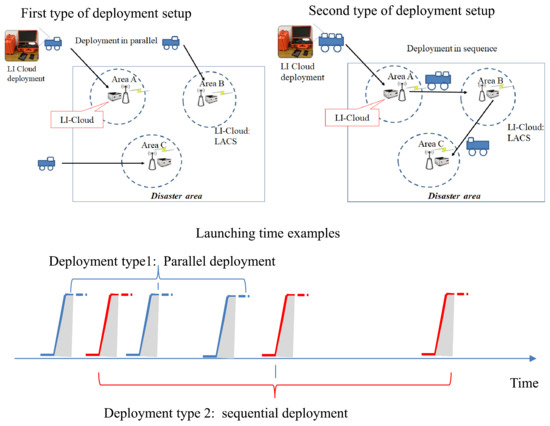
Figure 3.
Two types of launching time scenarios.
The choice of the restoration methods depends on the disaster situation and the available resources, which include a number of available operators and vehicles to deliver and operate LI-Clouds. When there are enough resources, the parallel distribution of LI-Clouds for launching local networking services is possible. In the case of insufficient resources, however, the distribution of LI-Clouds has to be conducted in a sequential manner that takes much more time than the parallel distribution. In the evaluation, two types of launching time distributions are employed, including Poisson and Uniform distributions.
Figure 4 shows the evaluation results of utilizing LI-Clouds with uniform distribution of launching time and parallel deployment. Compared with the conventional recovery scheme, using LI-Cloud increases networking service availability by 10.2 percent on average, and has a maximum of 42.1 percent increase in networking service availability.
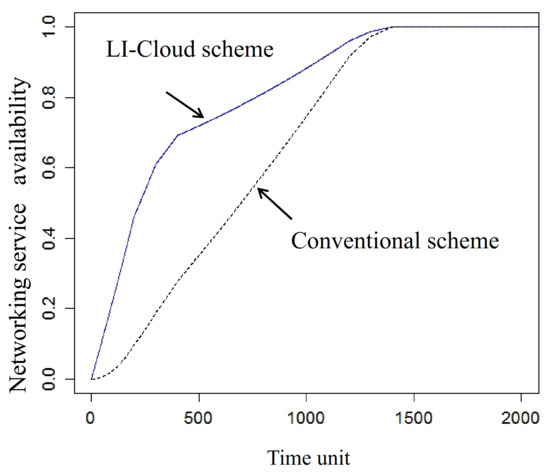
Figure 4.
I-NSA for users in the scenario of parallel deployment of networking services with (uniform distribution of restoration. Ta, Tb, and Tc are set to 200, 300, and 400, and , , and are set to 1200, 1300, and 1400, respectively).
Figure 5 shows the evaluation results of utilizing LI-Clouds with Possion distribution of launching time and parallel deployment. The I-NSA of using LI-Cloud achieves a 19.9% increase on average in networking service availability, and a maximum of 60% increase in networking service availability.
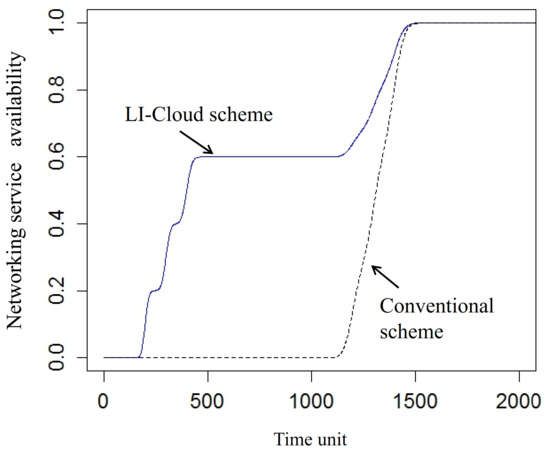
Figure 5.
I-NSA for users in the scenario of parallel deployment of networking services with (Possion distribution of restoration. Ta, Tb, and Tc are set to 200, 300, and 400, and , , and are set to 1200, 1300, and 1400, respectively.
Figure 6 shows the evaluation results of utilizing LI-Clouds with uniform distribution launching time and sequential deployment. The I-NSA of using LI-Cloud achieves a 10.6% increase on average in networking service availability, and a maximum of 32.4% increase in I-NSA.
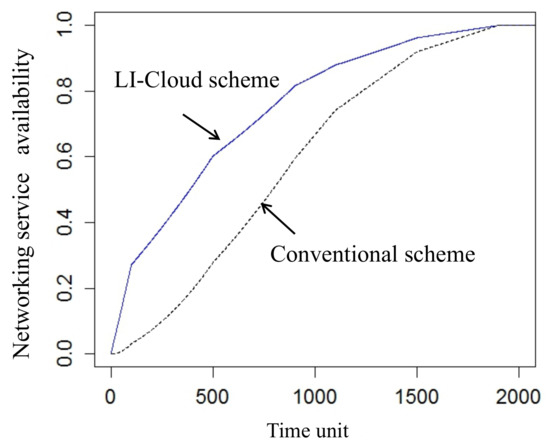
Figure 6.
I-NSA for users in the scenario of sequential deployment of networking services with (uniform distribution of restoration. Ta, Tb, and Tc are set to 100, 500, and 900, and , , and are set to 1100, 1500, and 1900, respectively).
Figure 7 shows the evaluation results of utilizing LI-Clouds with Poisson distribution of launching time and sequential deployment. Using LI-Cloud achieves an approximate 19% increase on average in networking service availability, and a maximum of 59.9% in I-NSA.
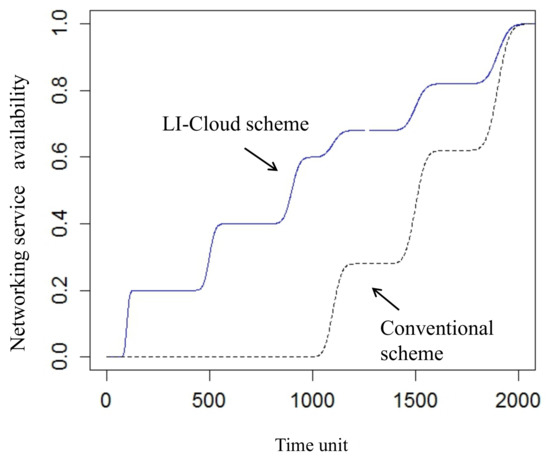
Figure 7.
I-NSA for users in the scenario of sequential deployment of networking services with (Possion distribution of restoration. Ta, Tb, and Tc are set to 100, 500, and 900, and , , and are set to 1100, 1500, and 1900, respectively).
Better performance achieved by utilizing LI-Clouds is attributed to the following two facts. (1) The LI-Cloud enables the local networking services even though there is no global networking service. (2) The fast launching of the LI-Cloud is enabled before the restoration of global networking services.
7. Discussion
7.1. State Machine Diagram in Networking Service Recovery
The state transition diagrams of each LI-Cloud server and each user in a disaster area are illustrated in Figure 8 and Figure 9, respectively. The set of states at an LI-Cloud server includes the state of no networking service, the state of local networking service launching, the state of local service area extension, and the state of global network service launching. The set of states at a user includes the state of no networking service, the state of local networking service, the state of connection to extended service area, and the state of global networking service available.
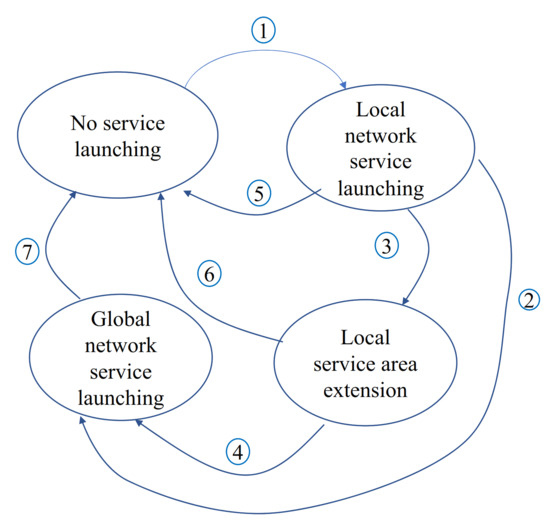
Figure 8.
State machine of an LI-Cloud server.

Figure 9.
State machine of a user.
For an LI-Cloud server, the state of no networking service refers to the state in which the server has not started its networking services yet. The state of local networking service launching is the state in which the LI-Cloud start to provide local networking services to users. The state of local service area extension refers to the state in which the LI-Cloud is connected to other LI-Clouds and enables the users in the LI-Cloud to communicate with users at other local clouds. The state of global network service launching refers to the state in which the LI-Cloud is connected to the Internet. For a user, the state of no networking service refers to the state in which the user has no networking services available. The state of local networking service is the state in which the user obtains the local networking services from its LI-Cloud server. The state of connection to an extended service area refers to the state in which the users are able to communicate with users at other local clouds. The state of global network service available refers to the state in which the user is able to connect to the Internet.
The conditions of state transition of an LI-Cloud server are described in Table 3, in which the number of transitions corresponds to the Figure 8. Moreover, the state transition conditions of a user are illustrated in Table 4, in which the number of transitions corresponds to the Figure 9.

Table 3.
State transition conditions of a user.

Table 4.
State transition conditions of an LI-Cloud server.
7.2. Limited Communication Range of LI-Cloud
The deployable LI-Cloud, such as LACS, may adopt wireless communication based on WLANs that are widely used. The limited communication range puts a constraint to the networking service coverage. On the other hand, considering the fact that the users often gather to the emergency center in a disaster situation, the WLAN-based communication is expected to not only be easily used by users but also to promptly provide networking services with a certain coverage efficiency.
7.3. Extended System
The detailed analyses of I-NSA have been carried out for the LI-Cloud-based networks. When the disaster areas involve a much higher number of LI-Clouds, the clustering of LI-Clouds is a possible way to extend this work for coordination among many Li-Clouds to provide networking services—that is, two or three LI-Clouds form a cluster when these LI-Clouds enable the local service coverage and have been connected with each other. Multiple (two or three) clusters are able to further construct a larger coverage cluster. In this way, the evaluation model discussed is expected to be applied for a large number of LI-Clouds.
8. Conclusions
In this paper, we examined the network restoration by utilizing instant networking service availability (I-NSA). Compared with conventional methods for measuring the networking availability, I-NSA is an integrated factor that involves both network connectivity and user distribution among various areas. I-NSA has its unique features that facilitate the design of novel networking services such as Local-and-Instant Clouds for disaster resilience. First, the I-NSA measures the networking service availability from the temporary and partial recovery of the network. Second, I-NSA allows us to assess the functionality and effectiveness of the network restoration process before the network is fully recovered. We especially examined the I-NSA of using LI-Clouds in a disaster situation. The evaluation results showed the significant improvement of networking service availability with utilization of LI-Clouds in various deployment scenarios of LI-Clouds.
Author Contributions
Conceptualization, R.T., T.S., and Y.S.; investigation, R.T. and T.S.; validation, R.T., T.S., and Y.S.; writing—review and editing, R.T., T.S., and Y.S. All authors have read and agreed to the published version of the manuscript.
Funding
This research is in part supported by an SIP Program on national resilience (disaster prevention and mitigation).
Acknowledgments
This work is in part supported by an SIP Program on national resilience (disaster prevention and mitigation).
Conflicts of Interest
The authors declare no conflict of interest.
References
- Sakano, T.; Kotabe, S.; Komukai, T.; Kumagai, T.; Shimizu, Y.; Takahara, A.; Ngo, T.; Fadlullah, Z.M.; Nishiyama, H.; Kato, N. Bringing Movable and Deployable Networks to Disaster Areas: Development and Field Test of MDRU. IEEE Netw. Mag. 2016, 30, 86–91. [Google Scholar] [CrossRef]
- Stute, M.; Maass, M.; Schons, T.; Hollick, M. Reverse Engineering Human Mobility in Large-scale Natural Disasters. In Proceedings of the 20th ACM International Conference on Modelling, Analysis and Simulation of Wireless and Mobile Systems (MSWiM), Miamim, FL, USA, 21–25 November 2017; pp. 219–226. [Google Scholar]
- Pervez, F.; Qadir, J.; Khalil, M.; Yaqoob, T.; Ashraf, U.; Younis, S. Wireless Technologies for Emergency Response: A Comprehensive Review and Some Guidelines. IEEE Access 2018, 6, 71814–71838. [Google Scholar] [CrossRef]
- Nishiyama, H.; Ito, M.; Kato, N. Relay-by-smartphone: Realizing multihop device-to-device communications. IEEE Commun. Mag. 2014, 52, 56–65. [Google Scholar] [CrossRef]
- Casoni, M.; Grazia, C.A.; Klapez, M.; Patriciello, N.; Amditis, A.; Sdongos, E. Integration of satellite and LTE for disaster recovery. IEEE Commun. Mag. 2015, 53, 47–53. [Google Scholar] [CrossRef]
- Florian, V.; Konstantinos, L.; Marius, C.; Joe, C.; Schwarz, R.T.; Thomas, S.; Troudt, E.; Andreas, K. Satellite Integration into 5G: Accent on First Over-The-Air Tests of an Edge Node Concept with Integrated Satellite Backhaul. Future Internet 2019, 11, 193. [Google Scholar]
- Ngo, T.; Nishiyama, H.; Kato, N.; Sakano, T.; Takahara, A. A Spectrum- and Energy-Efficient Scheme for Improving the Utilization of MDRU-based Disaster Resilient Networks. IEEE Trans. Veh. Technol. Spec. Sect. Green Mob. Multimed. Commun. 2014, 63, 2027–2037. [Google Scholar] [CrossRef]
- Dominiak, S.; Bayer, N.; Habermann, J.; Rakocevic, V.; Xu, B. Reliability Analysis of IEEE 802.16 Mesh Networks. In Proceedings of the 2nd IEEE/IFIP International Workshop on Broadband Convergence Networks, Munich, Germany, 21 May 2007. [Google Scholar]
- Meza, J.; Xu, T.; Veeraraghavan, K.; Mutlu, O. A Large Scale Study of Data Center Network Reliability. In Proceedings of the ACM Internet Measurement Conference, Boston, MA, USA, 31 October–2 November 2018. [Google Scholar]
- Sakano, T.; Teng, R.; Yano, K.; Shimizu, S.; Suzuki, Y. A Study on a system for alleviating communication difficulty based on promptly deployable local clouds in the disaster affected areas. In Proceedings of the IEICE General Conference, Tokyo, Japan, 19–22 March 2019; pp. 7–46. [Google Scholar]
- Lambiotte, R.; Blondel, V.D.; de Kerchove, C.; Huens, E.; Prieur, C.; Smoreda, Z.; Dooren, P.V. Geographical dispersal of mobile communication networks. Phys. A Stat. Mech. Appl. 2008, 387, 5317–5325. [Google Scholar] [CrossRef]
- Shao, C.; Tanaka, T. Prediction of Refugee Population in School Districts. J. Nat. Disaster Sci. 2012, 33, 37–48. [Google Scholar] [CrossRef][Green Version]
- Zhao, X.; Xu, W.; Ma, Y. Relationships Between Evacuation Population Size, Earthquake Emergency Shelter Capacity, and Evacuation Time. Int. J. Disaster Risk Sci. 2017, 8, 457–470. [Google Scholar] [CrossRef]
- Teng, R.; Sakano, T.; Ojetunde, B.; Suzuki, Y. A Study of Service-Availability Performance in a Network Restoration System with Local Clouds. In Proceedings of the IEICE Society Conference, Toyonaka, Japan, 10–13 September 2019; pp. 7–24. [Google Scholar]
- Kurose, J.F.; Ross, K.W. Computer Networking: A Top-Down Approach, 6th ed.; Pearson: London, UK, 2012. [Google Scholar]
- Pereira, N.C.V.N.; de Moraes, R.M. A comparative analysis of AODV route recovery mechanisms in wireless Ad Hoc networks. In Proceedings of the 2009 IEEE Latin-American Conference on Communications, Medellin, Colombia, 10–11 September 2009; pp. 1–6. [Google Scholar]
- Tajiki, M.M.; Shojafar, M.; Akbari, B.; Salsano, S.; Conti, M.; Singhal, M. Joint Failure Recovery, Fault Prevention, and Energy-efficient Resource Management for Real-time SFC in Fog-supported SDN. Comput. Netw. 2019, 162, 106850. [Google Scholar] [CrossRef]
- Pozza, M.; Rao, A.; Flinck, H.; Tarkoma, S. Network-In-a-Box: A Survey About On-Demand Flexible Networks. IEEE Commun. Surv. Tutor. 2018, 20, 2407–2428. [Google Scholar] [CrossRef]
- Sakano, T.; Fadlullah, Z.M.; Ngo, T.; Nishiyama, H.; Nakazawa, M.; Adachi, F.; Kato, N.; Takahara, A.; Kumagai, T.; Kasahara, H.; et al. Disaster-resilient networking: A new vision based on movable and deployable resource units. IEEE Netw. 2013, 27, 40–46. [Google Scholar] [CrossRef]
- Usuda, Y.; Hanashima, M.; Sato, R.; Sano, H. Effects and Issues of Information Sharing System for Disaster Response. J. Disaster Res. 2017, 12, 1002–1014. [Google Scholar] [CrossRef]
- Uchida, O.; Kosugi, M.; Endo, G.; Funayama, T.; Utsu, K.; Tajima, S.; Tomita, M.; Kajita, Y.; Yamamoto, Y. A Real-Time Disaster-Related Information Sharing System Based on the Utilization of Twitter. In Proceedings of the SOTICS 2015: The Fifth International Conference on Social Media Technologies, Communication, and Informatics, Barcelona, Spain, 15–20 November 2015; pp. 22–25. [Google Scholar]
- Aydin, C.; Tarhan, C.; Ozgur, A.S.; Tecim, V. Improving Disaster Resilience Using Mobile Based Disaster Management System. In Proceedings of the 9th International Conference Interdisciplinarity in Engineering, INTER-ENG 2015. Tirgu-Mures, Romania, 8–9 October 2015; pp. 382–390. [Google Scholar]
- Krings, G.; Calabrese, F.; Ratti, C.; Blondel, V.D. A gravity model for inter-city telephone communication networks. J. Stat. Mech. Theory Exp. 2009, 7003, 1–8. [Google Scholar]
- Hazra, K.; Shah, V.K.; Bilal, M.; Silvestri, S.; Das, S.K.; Nandi, S.; Saha, S. A Novel Network Architecture for Resource-Constrained Post-Disaster Environments. In Proceedings of the 2019 11th International Conference on Communication Systems & Networks (COMSNETS), Bengaluru, India, 7–11 January 2019; pp. 328–335. [Google Scholar]
- Nakamura, I. Telecommunications and Disaster in the Era of IP Networks―The Connectivity of Telecommunication Media after the 2016 Kumamoto Earthquake. In Toyo University Repository for Academic Resources; Toyo University: Tokyo, Japan, 2017; pp. 33–49. [Google Scholar]
- Sakano, T.; Meguri, M.; Teng, R.; Ojetunde, B.; Suzuki, Y. A Study on the usability of a portable Locally Accessible Cloud System for disaster countermeasure. In Proceedings of the IEICE General Conference, Higashi-Hiroshima-City, Japan, 17–20 March 2020; pp. 7–21. [Google Scholar]
- Sakano, T.; Meguri, M.; Teng, R.; Ojetunde, B.; Suzuki, Y. A Study on the applicability of a portable Locally Accessible Cloud System as a local information platform in the developing countries. In Proceedings of the IEICE Society Conference, Tokushima-City, Japan, 15–18 September 2020; p. 7. [Google Scholar]
Publisher’s Note: MDPI stays neutral with regard to jurisdictional claims in published maps and institutional affiliations. |
© 2020 by the authors. Licensee MDPI, Basel, Switzerland. This article is an open access article distributed under the terms and conditions of the Creative Commons Attribution (CC BY) license (http://creativecommons.org/licenses/by/4.0/).